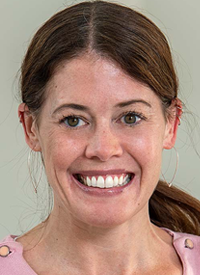Are Oncology Nurses Underutilized in Positively Affecting the Opioid Epidemic?
Gretchen McNally PhD, ANP-BC, AOCNP, discusses the potential impact advanced practice providers and nurses could have in the opioid pandemic if the correct educational opportunities were available.
Gretchen McNally, PhD, ANP-BC, AOCNP

Naloxone (Narcan) training for oncology nurses and advanced practiced providers (APPs) may be an opportunity to decrease addiction stigma and save lives, according to Gretchen McNally, PhD, ANP-BC, AOCNP.
McNally, who is a nurse practitioner in hematology at The Ohio State University Comprehensive Cancer Center– Arthur G. James Cancer Hospital and Richard J. Solove Research Institute (OSUCCC), recently presented during the 47th Annual Oncology Nursing Society (ONS) about how oncology nurses might have the opportunity to save lives with proper naloxone training. Responses obtained from nurses and APPs at McNally’s institution demonstrated that they would feel comfortable administering naloxone, provided they had the proper training, and would be interested in pursuing educational trainings on the agent.
“This represents an opportunity for oncology nurses and APPs to positively impact the opioid epidemic, for not only patients affected by cancer, but there may be a positive trickle-down effect on families and communities,” said McNally in a presentation of the findings.
In an interview with Oncology Nursing News®, McNally walked through the background of Project Dawn, which stands for “deaths avoided with naloxone,” the significance of the findings of her research, and what oncology nurses should understand about naloxone’s role in the opioid epidemic.
“[Project Dawn] is partnered with several of the health care systems, including Ohio State,” McNally said. “Project Dawn supplies free naloxone to [individuals] at risk of an opioid overdose—patients who have an opioid use disorder, [have had] a previous overdose, or [are receiving] a high dose of pain medications,” she explained.
“In October of 2021, [Project Dawn was] rolled out at the [OSUCCC]. I thought it was very innovative. They had a short 14-minute video that went through recognizing an opioid overdose and how to administer the naloxone, which in the community is usually [administered] as a nasal spray [but in] the hospital or it’s usually administered intravenously or intramuscularly.”
“I think that this is an opportunity to develop creative or innovative strategies to train health care providers and nurses,” she added. “If you think of how many nurses work at the hospital, and then go into the communities, they could really make a huge difference.”
“I always go back to thinking about Jan Rader, who was a fire chief in West Virginia. She gave a TED talk in 2019 [and] said, ‘We all have a role to play in ending the opioid epidemic, and what role will you play?’ As an oncology nurse or provider, you [may] not really think that addiction affects your patients, [but] it affects so many people, and if we can just make a small difference and save 1 life, we’re making an impact.”
McNally and coinvestigators conducted a hospital-wide survey of multidisciplinary oncology health care providers over a 4-week period. Respondents were queried about their experience and knowledge surrounding opioid use disorders. The results presented during ONS highlighted responses on the providers’ knowledge of naloxone administration.
Overall, 698 participants were included in the sample. Among these were 180 APPs and 518 nurses, and the response rates were 50% and 43%, respectively. The mean age of participants was 40.2 years for APPs and 38.4 years for nurses. Most participants were female (n = 641, 91.8%) and White (n = 631, 90.4%). The percentage of respondents who had worked in oncology for over 5 years was 62.3% for APPs and 49.7% for nurses.
Participants were asked to respond to the following statements:
“I feel comfortable administering naloxone in the community”
“I would feel comfortable with training”
“Would you be interested in attending a naloxone training class?”
For the first question, “I feel comfortable administering naloxone in the community”, a greater number of APPs (39.4%; n = 69) compared with nurses (29.1%; n = 145) responded “no.” However, the majority of both nurses (64.2%; n = 309) and APPs (60.1%; n = 104) answered “yes” to the second question, “I would feel comfortable with training.”
Moreover, most nurses (64.2%; n = 309) and APPs (60.1%; n = 104) expressed interest in naloxone training classes.
McNally concluded the conversation noting that with the enthusiasm exhibited by nurses in regards to naloxone training, it is important to understand it’s specific value in reducing harm.
“Naloxone is a reversal agent. I like to think of it as a fire extinguisher—only to be used in times of emergency,” she said. “It’s a great example of harm reduction. It recognizes that opioid use is going to continue, [however, with it] we can potentially save a life.”
Reference
McNally G, McLaughin E, Baiochhi R, Rosselet R. Naloxone training: an opportunity for oncology nurses to save lives. Presented at: 47th Annual Oncology Nursing Society Congress; April 27-May 1, 2022, Anaheim, CA. Abstract P147.



